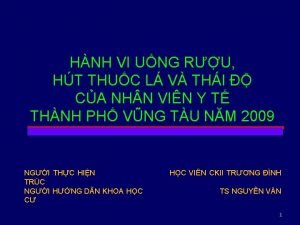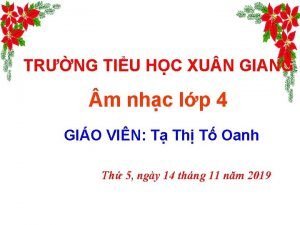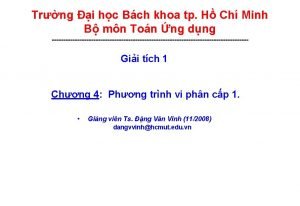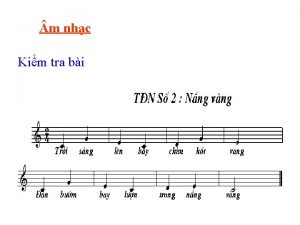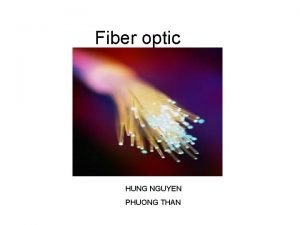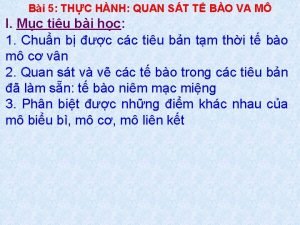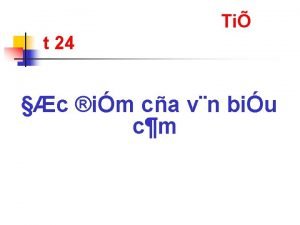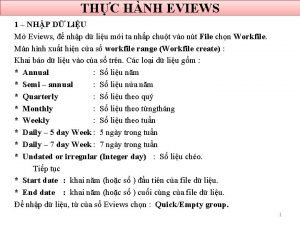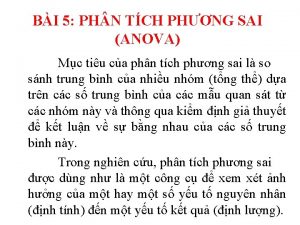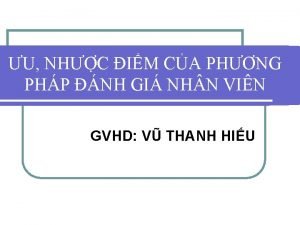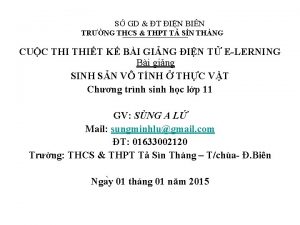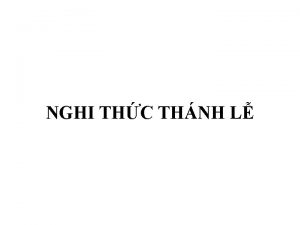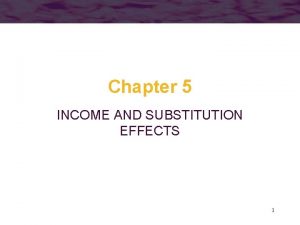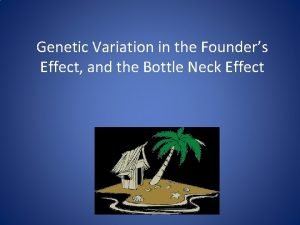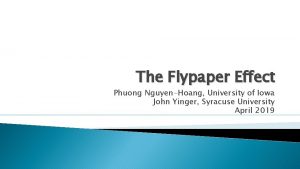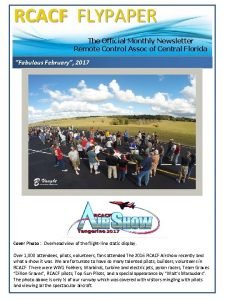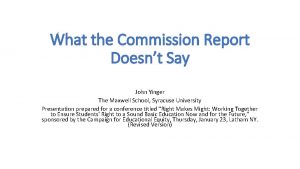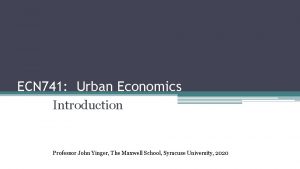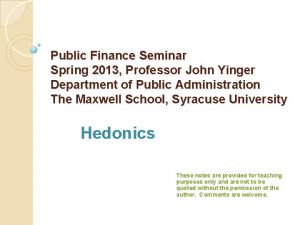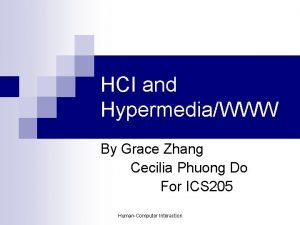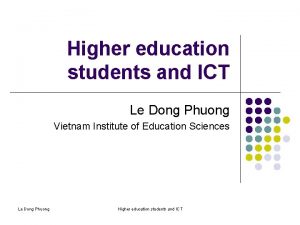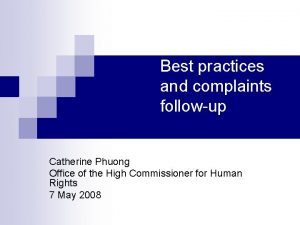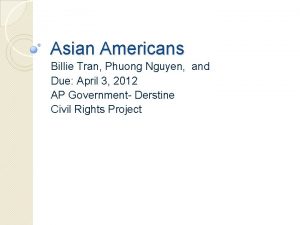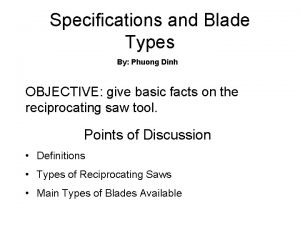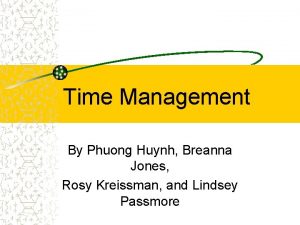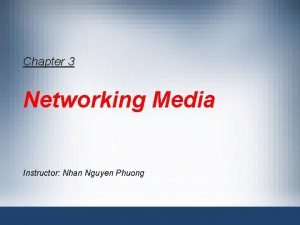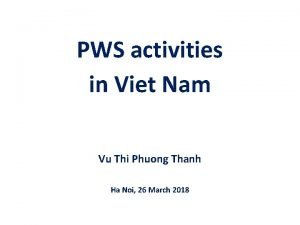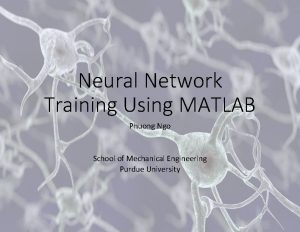The Flypaper Effect Phuong NguyenHoang and John Yinger





































- Slides: 37

The Flypaper Effect Phuong Nguyen-Hoang and John Yinger Draft, April 2017

The Flypaper Effect Introduction Over the last fifty years ago, many scholars have found that, in per capita terms, the impact of $1 of state aid on public expenditure is larger than the impact of $1 of household income. This phenomenon is known as the flypaper effect, and it has been found to exist for many levels of government in many countries. (The term was apparently coined by Arthur Okun. ) Despite a voluminous literature (Inman 2008 found over 3, 500 papers on the topic!), no scholarly consensus exists on the flypaper effect’s magnitude or causes.

The Flypaper Effect Introduction, 2 This paper reviews what has been learned about the methodology required to estimate flypaper effects; uses the Slutsky equation to show, for the first time, that flypaper effects are not confined to lumpsum aid; and reviews behavioral explanations for the flypaper effect. Based on the results for New York State in Eom et al. (2014) and Nguyen-Hoang and Yinger (2016) and on new results for “hidden” flypaper effects, we find support for the argument in Hines and Thaler (1995) that the flypaper effect arises from framing. We also show that the magnitude of this effect may reflect the salience of events in the local public sector.

The Flypaper Effect Introduction, 3 This presentation has two parts (1) A review of the literature on estimating flypaper effects, with a focus on state aid to K-12 education. (2) The introduction of two new flypaper effects, one of which applies to matching aid. (3) (If time) Tests of theories about the causes of flypaper effects.

The Flypaper Effect Early Studies Several studies in the late 1960 s and early 1970 s estimated an equation of the form: where E is school spending, Y is household income, A is lump-sum aid —all measured in per pupil terms. This equation was interpreted as a constant-elasticity demand function, that is, as the school spending that was demanded by voters in a district with income Y and state aid A, controlling for other demand factors, indicated by X. (K is a constant. ) The flypaper effect is defined to be ϕ/θ. Estimating the Flypaper Effect

The Flypaper Effect Early Studies, 2 An early review of the flypaper effect literature finds that “The current expenditure response to revenue sharing is roughly five times that of the response to private income” (Gramlich and Galper 1973). A later review (Duncombe 1996) finds that the flypaper effect is in the range of 2 to 5. Estimating the Flypaper Effect

The Flypaper Effect The Fundamental Nonlinearity of Aid Let Z stand for spending on the composite good, H for housing services, P for the price of housing services, and T for a property tax payment. The value of a house is V = PH/r, where r is a discount rate, and PH is the annual spending on housing. So the household budget constraint is: Now let t be the property tax rate so that T = t. V in a homogeneous school district and the district budget constraint is: Estimating the Flypaper Effect

The Flypaper Effect The Fundamental Nonlinearity of Aid, 2 Solving the district constraint for t and substituting it into the household constraint yields the combined budget constraint: Hence the income term in the budget constraint is (Y + A), and the corresponding variable in a constant-elasticity demand function is ln{Y + A}. An estimate of the flypaper effect requires a separate coefficient on each of these terms, or θln{Y + (1 + f )A}, where θ is the income elasticity of demand for education and f is the flypaper effect. Estimating the Flypaper Effect

The Flypaper Effect The Fundamental Nonlinearity of Aid, 3 This formulation is obviously nonlinear, which makes it difficult to estimate. To obtain a close linear approximation, we can re-write the above expression as Because ln{1 + a} ≈ a when a is a small fraction and because A/Y is a small fraction, this expression can be closely approximated by Estimating the Flypaper Effect

The Flypaper Effect The Fundamental Nonlinearity of Aid, 4 Replacing the formulation in the early studies with this formulation leads to a new estimating equation: γ Define the coefficient of the unlogged (A/Y) term as γ. Then the estimate of the flypaper effect is [γ /θ – 1]. Estimating the Flypaper Effect

The Flypaper Effect The Bradford/Oates Equivalence Theorem Bradford and Oates (1971) and Oates (1972) showed that the value of $1 of aid to a voter depends on the voter’s tax price. With heterogeneous voters, the outcome is determined by the median voter, and the budget constraint accounts for the overall property value in the district. To be specific, let be property value per pupil in a school district. Then the district budget constraint is Estimating the Flypaper Effect

The Flypaper Effect The Bradford/Oates Equivalence Theorem, 2 With this addition, the combined budget constraint becomes: In this model, the tax-price term, , is, of course, what it cost the voter to obtain another unit of E, but it is also a weight applied to state aid. Adding a flypaper effect and the above approximation, the expression for income augmented by aid, labeled , is: Estimating the Flypaper Effect

The Flypaper Effect The Bradford/Oates Equivalence Theorem, 3 This formulation appears in Inman (1979) and Fisher (1982), although their terminology is somewhat different. These authors do not, however, provide the associated estimating equation. This equation is: Estimating the Flypaper Effect

The Flypaper Effect A Switch to Student Performance Bradford, Malt, and Oates (1969) explain that voters care about final outputs, not spending as such, and the costs that link spending and output vary with a jurisdiction’s spending environment. Let S be student performance and E{S} be its cost function. Then the tax price of S is the product of the marginal cost of S, MC, and the (relabeled) tax share, . Now the demand function is Estimating the Flypaper Effect

The Flypaper Effect A Switch to Student Performance, 2 One way to estimate this demand function is to assume that the average cost of S (i. e. the cost per unit of output = AC) equals MC and to multiply sides of the unlogged version of the above equation by AC. Because E = (S)(AC), this results in: This approach is used by Rockoff (2010). Estimating the Flypaper Effect

The Flypaper Effect A Switch to Student Performance, 3 Eom et al (2014) estimate Rockoff’s approach using data from New York State from 1998 to 2011. The control for cost factors and (following Rockoff) for district fixed effects. This study considers the price effect of property tax exemptions as well as the standard tax price. They estimate that the flypaper effect is 20. 7. This study also rejects the assumption behind the Rockoff approach, namely that AC = MC. Estimating the Flypaper Effect

The Flypaper Effect Introducing a Cost Function The only way to eliminate the assumption that AC = MC is to add a cost function to the model. And a cost function requires an analysis of school district efficiency. We use the approach developed in Duncombe and Yinger (2011), Eom et al. (2014), and Nguyen-Hoang and Yinger (2014). This approach involves estimating a new equation, namely, where C is best-practices cost to deliver performance S and e equals 1 in an efficient district and is less than 1 in an inefficient district. Estimating the Flypaper Effect

The Flypaper Effect Introducing a Cost Function, 2 In this context, S is a specific measure of student performance and efficiency measures not only waste but also spending on other types of student performance, say S*. Because voters value S*, the efficiency component of this equation is specified like the demand function, with some extra controls to indicate factors associated with voter monitoring. This approach leads to a two structural equations, which can be estimated with 2 SLS; all of the parameters, including the flypaper effect are identified. Estimating the Flypaper Effect

The Flypaper Effect Introducing a Cost Function, 3 Eom et al. (2014) estimate this model using data for school districts in New York State from 1998 to 2011; NYC is excluded. The measure of S is an index of test scores and graduation rates. This study finds a statistically significant flypaper effect of 52. 1. Estimating the Flypaper Effect

The Flypaper Effect Accounting for Salience and Framing Hines and Thaler (1995) argue that the flypaper effect reflects the behavioral economics concept of framing. In this context, framing arises when households put different sources of revenue in different mental accounts with links to different types of spending. The flypaper effect also might be influenced by the salience of related features of a state’s school finance system. Salience is a behavioral economics concept that denotes visibility; people are likely to have larger responses to school finance changes that are more salient. Estimating the Flypaper Effect

The Flypaper Effect Accounting for Salience and Framing, 2 The STAR program in New York State provides a unique opportunity to look for the role of salience and framing. STAR is state-funded property tax exemption from school taxes. It is equivalent to an open-ended matching grant with a local share equal to (1 – X/V), where X is the exemption amount and V is a voter’s property value. The exemption amount varies across districts and over time. This STAR-based local share alters the value of aid to voters, so it is part of the augmented income specification that identifies the flypaper effect. Estimating the Flypaper Effect

The Flypaper Effect Accounting for Salience and Framing, 3 STAR leads to a test of framing, because basic STAR property tax exemptions were supplemented by rebates in the 2007 -2009 period. These two types of property tax relief are algebraically equivalent, but the exemptions are framed as part of the property tax bill, which links to the public spending mental account, and the rebates arrived in the mail and are framed as unlabeled income. Nguyen-Hoang and Yinger (2016; henceforth N/Y) hypothesize that voters will perceive the impact of the exemptions on the value of state aid, but will not alter this perception when rebates are added. Estimating the Flypaper Effect

The Flypaper Effect Accounting for Salience and Framing, 4 STAR also leads to a test of salience, because STAR was phased in and heavily publicized in its early years. High salience for STAR implies that voters are aware that STAR lowers the value they receive from each dollar of state aid. N/Y hypothesize that this greater awareness will result in a lower flypaper effect in the phase-in years. Estimating the Flypaper Effect

The Flypaper Effect Accounting for Salience and Framing, 5 The N/Y results support these hypotheses. N/Y Flypaper Effects Estimating the Flypaper Effect f for year = 1999 (no STAR) 34. 9*** f for year = 2000 (Phase-in Year) 35. 8*** f for year = 2001 (Phase-in Year) 41. 0*** f for year = 2002 (Phase-in Year) 54. 4*** f for year = 2003 -06 and 2010 -11 56. 2*** f for year = 2007 (Rebate Year) 57. 2*** f for year = 2008 (Rebate Year) 52. 1*** f for year = 2009 (Rebate Year) 42. 8***

The Flypaper Effect Two New Flypaper Effects This analysis of flypaper effects leads to two new types of flypaper effects: Efficiency flypaper effects, which are flypaper effects hidden in the efficiency equation. Slutsky flypaper effects, which are flypaper effects hidden in price elasticities but illuminated by the Slutsky equation. Two New Flypaper Effects

The Flypaper Effect Efficiency Flypaper Effects Recall that one component of inefficiency is spending on school services other than the ones specified in S, called S*. Recall that voters have a demand for S*, and that this demand, like the demand for S, depends on, among other things, voter income augmented by state aid. The Eom et al. approach (and the N/Y approach) therefore estimate an efficiency flypaper effect as part of the first-stage expenditure equation. To keep the two flypaper effects separate, we call the standard flypaper effect f D and the efficiency flypaper effect f E. Two New Flypaper Effects

The Flypaper Effect Efficiency Flypaper Effects, 2 Intuitively, f D and f E are similar to a decomposition of the traditional flypaper effect, which is based on school spending. Specifically, f D measures the flypaper effect associated with a selected, and presumably central, index of school quality, S, and f E measures the flypaper effect associated with all other school quality measures or, to put it another way, with all spending not directed to S. This comparison is not exact, however, because estimates of the traditional flypaper effect, unlike estimates of f D and f E, require the assumption of constant returns to quality scale. Estimates of f D and f E are therefore more precise and more general than traditional estimates. Two New Flypaper Effects

The Flypaper Effect Efficiency Flypaper Effects, 3 Efficiency flypaper effects were first estimated by Duncombe, Lukemeyer, and Yinger (2008), although they did not focus on it. Eom et al. (2014) find that f E = 59. 8, which is similar to their estimate of the standard flypaper effect: f D = 52. 1 As shown on the next page, N/Y find that the time pattern is very similar for the standard and efficiency flypaper effects. This evidence indicates that state education aid has a larger-thanincome impact on the spending associated with many types of school performance measures, not just those that are highlighted in academic studies and state accountability systems. Two New Flypaper Effects

Standard and Efficiency Flypaper Effects 70 60 50 40 30 20 10 0 1998 2000 2002 2004 Standard Two New Flypaper Effects 2006 Efficiency 2008 2010 2012

The Flypaper Effect Slutsky Flypaper Effects Open-ended matching grants are rarely used for state education aid, but as shown by Rockoff (2010) and Eom et al. (2014), STAR is equivalent to this type of aid; so STAR provides an opportunity to estimate the extent to which voters respond to a change in the price of local education. From the perspective of this paper, STAR also makes it possible to estimate a third type of flypaper effect, which is hidden in the price elasticity of demand estimated by Rockoff and Eom et al. According to the Slutsky equation, the behavioral response to a price reflects both a substitution effect and an income effect. This income effect could have a flypaper effect attached to it. So the behavioral response to the implicit income increase from the STAR tax exemptions could be greater than the behavioral response to an equivalent change in household income. Two New Flypaper Effects

The Flypaper Effect Slutsky Flypaper Effects, 2 The elasticity form of the Slutsky equation is where μC is the compensated price elasticity, s is education’s budget share, and θ is the income elasticity. We argue that the income effect in this formula (the last term) may include a pricelinked flypaper effect, labeled f P, so that We are working on a way to estimate f P using this equation. Any ideas!!? ? Two New Flypaper Effects

The Flypaper Effect What Causes the Flypaper Effect? Theory 1: Deadweight Loss Jonathan Hamilton (1986) and Dahlby (2011) argue that the perceived marginal cost of public services includes the deadweight loss from the taxation required to fund it. Intergovernmental grants lower this MC at the before-grant level of S and thus provide a price incentive, which does not arise with income increases, to increase S. This theory requires implausible assumptions: (1) Voters select private goods but the government independently selects the level of S. (2) Each voter assumes that everyone else will act just like she does, which implies that a voter’s selected level of the taxed good can be treated as the tax base. What Causes the Flypaper Effect?

The Flypaper Effect What Causes the Flypaper Effect? Theory 2: Citizen Misperception Courant, Gramlich, and Rubinfeld (1979) amd Oates (1979) argue that voters think their tax share is not but is instead their property taxes divided by their jurisdiction’s spending. State aid lowers this ratio and is misperceived as a price reduction. This theory is contradicted by the widespread finding that the demand for S depends on. What Causes the Flypaper Effect?

The Flypaper Effect What Causes the Flypaper Effect? Theory 3: The Power of Public Officials Filimon, Romer, and Rosenthal (1982) argue that voters are generally unware of aid. This ignorance allows public officials to spend the aid money on their own preferred projects. This theory is contradicted by the widespread finding that voters know enough about aid to adjust it for , as in the Bradford/Oates equivalency theorem. Wyckoff (1988) says that public officials have more bargaining power than voters in the disposition of aid than in the income, because aid stays in the jurisdiction when a voter leaves. This theory is contradicted by the N/Y finding that adding the STAR exemption did not lower the flypaper effect (as predicted by the loss of public officials’ bargaining power). What Causes the Flypaper Effect?

The Flypaper Effect What Causes the Flypaper Effect? Theory 4: Politics Chernick (1979) and Knight (2002) argue that governments wanting to increase spending lobby for more aid, which leads to reverse causation and upward bias in the aid variable. For this to be a problem in studies with district fixed effects (Rockoff 2010, Eom et al. 2014, N/Y), the unobserved district traits that affect both A and S would have to vary over time, which seems unlikely. What Causes the Flypaper Effect?

The Flypaper Effect What Causes the Flypaper Effect? Theory 5: Framing (Adjusted for Salience) Hines and Thaler (1995) argue that the flypaper effect arises because of framing. Changes in state aid appear in voter’s mental account for S, where they have a disproportionate impact on the demand for S compared to the impact of changes in household income. As shown by N/Y, the STAR rebates provide a natural experiment to test this theory because the STAR tax exemption appears on a voter’s tax bill, which is part of the mental account for S, but the STAR rebate check arrives in mail as unlabeled income. The N/Y finding that the rebates have no impact on the flypaper effect supports this framing hypothesis. N/Y also show that the flypaper effect varies with the salience of the tax price in a given year. What Causes the Flypaper Effect?

The Flypaper Effect Conclusions Dozens of studies find a flypaper effect. The magnitude of the flypaper effect varies enormously; the studies with the best methodologies find the largest values (≈ 50). Flypaper effects arise both for school performance measures explicit in the demand function and for other measures implicit in the cost function. Flypaper effects may arise with matching grants (or equivalent property tax exemptions) through the income term in the Slutsky equation. The evidence clearly points to framing as the best explanation for the flypaper effect, with an adjustment for salience. Conclusions
 Cừu dolly được sinh ra bằng phương pháp
Cừu dolly được sinh ra bằng phương pháp Phuong nam garment joint stock
Phuong nam garment joint stock Giải phương trình bậc 1 sql
Giải phương trình bậc 1 sql Phương pháp nghiên cứu cắt ngang
Phương pháp nghiên cứu cắt ngang Biểu đồ karnaugh 4 biến
Biểu đồ karnaugh 4 biến Chúa ơi con thờ phượng ngài
Chúa ơi con thờ phượng ngài Khi trong phương đông vừa hé ánh dương
Khi trong phương đông vừa hé ánh dương Phương trình vi phân
Phương trình vi phân Phuong dung
Phuong dung Phương trình bernoulli
Phương trình bernoulli Phún xạ magnetron
Phún xạ magnetron Khi trong phương đông vừa hé
Khi trong phương đông vừa hé Phuong than
Phuong than Tóm tắt phương pháp làm tiêu bản mô cơ vân
Tóm tắt phương pháp làm tiêu bản mô cơ vân Hãy tìm mạch ý của bài văn hoa học trò
Hãy tìm mạch ý của bài văn hoa học trò Kiểm định ramsey trong eviews
Kiểm định ramsey trong eviews Phân tích phương sai 2 yếu tố
Phân tích phương sai 2 yếu tố Phương pháp bản tường thuật
Phương pháp bản tường thuật Phương pháp ghép cành
Phương pháp ghép cành Phương pháp bản tường thuật
Phương pháp bản tường thuật Kinh tin kính
Kinh tin kính Viễn phương
Viễn phương Phuong d nguyen
Phuong d nguyen Bohr's effect in respiration
Bohr's effect in respiration Substitution effect and income effect
Substitution effect and income effect Founder effect vs bottleneck effect
Founder effect vs bottleneck effect Hình ảnh bộ gõ cơ thể búng tay
Hình ảnh bộ gõ cơ thể búng tay Ng-html
Ng-html Bổ thể
Bổ thể Tỉ lệ cơ thể trẻ em
Tỉ lệ cơ thể trẻ em Gấu đi như thế nào
Gấu đi như thế nào Chụp phim tư thế worms-breton
Chụp phim tư thế worms-breton Alleluia hat len nguoi oi
Alleluia hat len nguoi oi Môn thể thao bắt đầu bằng từ chạy
Môn thể thao bắt đầu bằng từ chạy Thế nào là hệ số cao nhất
Thế nào là hệ số cao nhất Các châu lục và đại dương trên thế giới
Các châu lục và đại dương trên thế giới Công thức tiính động năng
Công thức tiính động năng Trời xanh đây là của chúng ta thể thơ
Trời xanh đây là của chúng ta thể thơ



